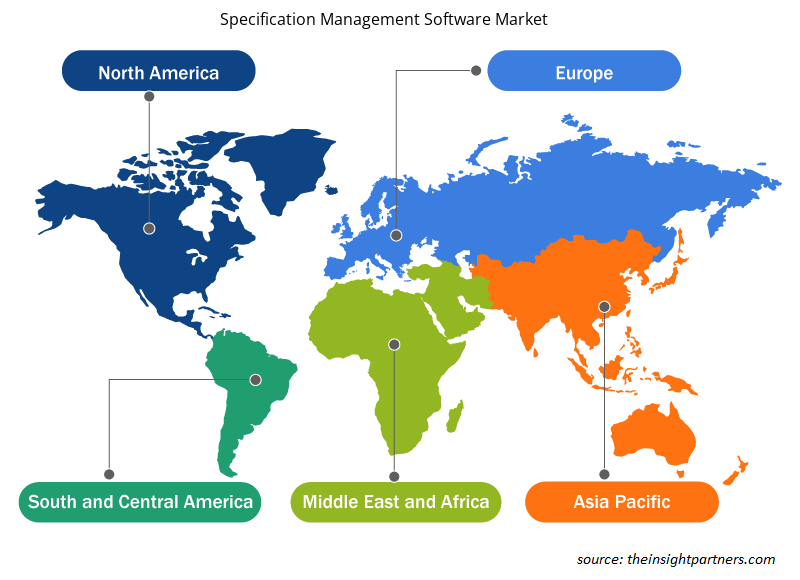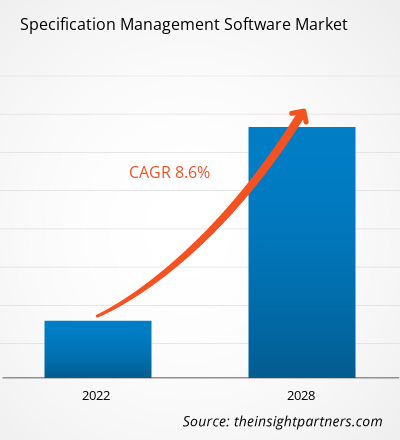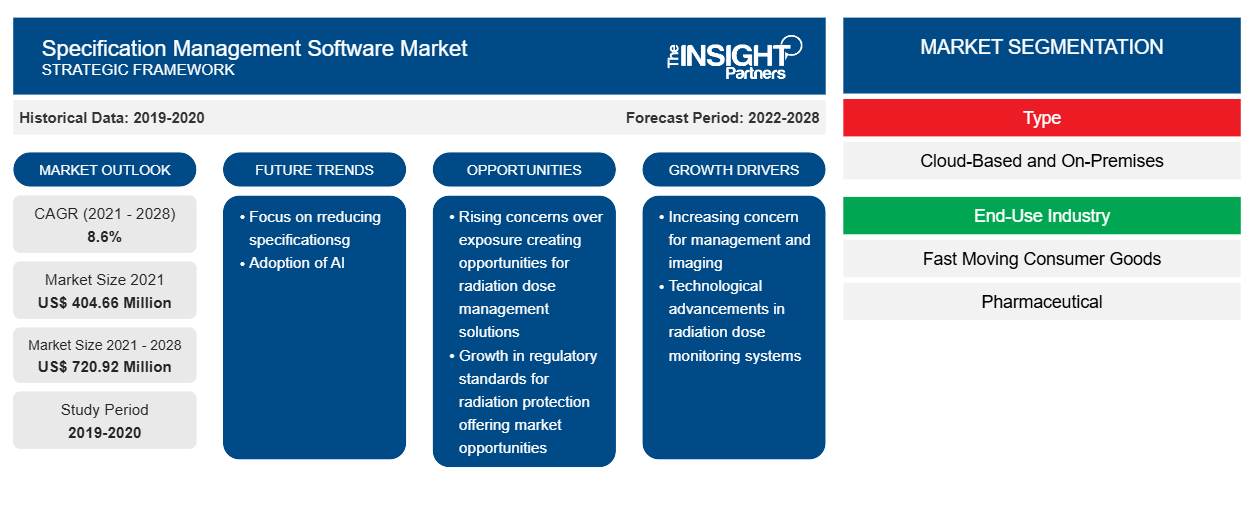Se espera que el mercado de software de gestión de especificaciones crezca de US$ 404,66 millones en 2021 a US$ 720,92 millones en 2028; se estima que crecerá a una CAGR del 8,6% durante 2021-2028.
Los productos farmacéuticos se fabrican combinando distintos tipos de sustancias químicas o biológicas. El proceso de fabricación implica una serie de operaciones unitarias, como la granulación, el llenado, la mezcla, la molienda, el prensado de comprimidos y el recubrimiento. Los fabricantes deben cumplir una normativa específica y seguir las directrices adecuadas para mantener la cantidad exacta de productos químicos y mantener su calidad. El equipo utilizado en la fabricación de productos farmacéuticos debe funcionar y mantenerse de acuerdo con las buenas prácticas de fabricación (BPF). Con el aumento continuo de la demanda de medicamentos en todo el mundo, las empresas farmacéuticas están invirtiendo significativamente en la implementación de diversas soluciones de TI en diferentes operaciones. Por ejemplo, se adopta un software de gestión de especificaciones para la especificación precisa y precisa de los productos químicos utilizados en la fabricación de productos farmacéuticos; esto ayuda a las empresas farmacéuticas a garantizar la calidad y el cumplimiento normativo en toda la cadena de valor de la industria.
Las cadenas de suministro complejas, las regulaciones estrictas y los problemas de integridad de los datos afectan las estrategias y los procesos de calidad en la industria farmacéutica. La FDA y otras autoridades equivalentes se centran rigurosamente en el cumplimiento normativo por parte de las empresas farmacéuticas, garantizando así el mantenimiento de los estándares de calidad en toda la industria farmacéutica mundial. Los datos del software de gestión de especificaciones permiten a los usuarios mantener métricas consistentes, cálculos de riesgos y otros análisis de tendencias. La función del software de gestión de especificaciones abarca la gestión de materias primas, la gestión de fórmulas e ingredientes, la gestión de envases, la gestión de documentos y la gestión de calidad. Por ejemplo, Pilgrim Quality Solutions ofrece soluciones SmartSolve Pharmaceutical QMS que gestionan de forma precisa y exacta la gestión de documentos, la gestión de productos fuera de especificación, la gestión de retiradas de productos, la gestión de calidad de los proveedores, etc.
Personalice este informe según sus necesidades
Obtendrá personalización en cualquier informe, sin cargo, incluidas partes de este informe o análisis a nivel de país, paquete de datos de Excel, así como también grandes ofertas y descuentos para empresas emergentes y universidades.
- Obtenga las principales tendencias clave del mercado de este informe.Esta muestra GRATUITA incluirá análisis de datos, desde tendencias del mercado hasta estimaciones y pronósticos.
Impacto de la pandemia de COVID-19 en el mercado de software de gestión de especificaciones en América del Norte
La pandemia de COVID-19 ha afectado gravemente a muchas industrias en países de América del Norte, como Estados Unidos, Canadá y México.El aumento sin precedentes en el número de casos de COVID-19 en los EE. UU. y la posterior imposición de varias restricciones para combatir la propagación del virus en los primeros dos trimestres de 2020 obstaculizaron el desempeño de varias empresas. Las inversiones tecnológicas sufrieron una caída considerable en 2020. Sin embargo, la pandemia afectó la forma en que trabajan las empresas y las alentó a utilizar plataformas digitales para realizar operaciones comerciales desde ubicaciones remotas. América del Norte está a la vanguardia en la aceptación y el desarrollo de tecnologías de vanguardia debido a las políticas gubernamentales favorables para impulsar la innovación y reforzar las capacidades de infraestructura. Dado que EE. UU. tiene una alta densidad de actores del mercado de software de gestión de especificaciones , el brote ha afectado gravemente la producción de cada uno, especialmente a principios de 2020, cuando hubo estrictas restricciones al transporte.
Perspectivas del mercado del software de gestión de especificaciones
El floreciente sector de bienes de consumo masivo impulsa el crecimiento del mercado de software de gestión de especificaciones
El sector mundial de bienes de consumo de rápido movimiento (FMCG) se encuentra bajo una presión continua para lanzar nuevos productos. Todos los lanzamientos de productos pasan por un ciclo de desarrollo de producto para entregar cada proyecto en un marco de tiempo específico. El sector de FMCG está experimentando un crecimiento saludable de forma constante, que se atribuye principalmente a la adopción de la venta minorista inteligente. El concepto de venta minorista inteligente obliga a los minoristas a centrarse continuamente en satisfacer los requisitos de los consumidores en constante evolución, así como en proporcionar una experiencia de compra mejorada y conveniente a los consumidores. En la industria de bienes de consumo, el software de gestión de especificaciones se implementa en procesos como la gestión de materias primas, el embalaje y la documentación de detalles del producto. El embalaje tiene la máxima importancia, ya que es el primer aspecto que los consumidores observan y tocan. PackIQ, ORBIS Corporation, TODAY IT, GEFCO y Amatech se encuentran entre los proveedores de herramientas de gestión de embalajes para el sector minorista y de bienes de consumo.
Además, la calidad del producto sigue siendo la principal preocupación de los consumidores. Por ello, las empresas, especialmente en la industria de bienes de consumo, se centran continuamente en ofrecer productos de calidad estándar de manera oportuna y sin complicaciones. La consiguiente necesidad de mejorar los procesos, los servicios y los resultados requiere la intervención de la tecnología, lo que está impulsando la adopción de software de gestión de especificaciones. Como resultado, la adopción de software de gestión de especificaciones para la gestión de documentos, la gestión de embalajes y la gestión de diseños está en aumento en el sector de bienes de consumo masivo, lo que permite además a los minoristas alcanzar la excelencia del cliente.
Perspectivas de mercado basadas en tipos
Según el tipo, el mercado de software de gestión de especificaciones se divide en basado en la nube y en local. En 2020, el segmento basado en la nube representó una mayor participación en el mercado.
Perspectivas de mercado basadas en aplicaciones
Residencia en
solicitud
El mercado de software de gestión de especificaciones está segmentado en gestión de materias primas, gestión de fórmulas e ingredientes, gestión de envases, gestión de documentos y otras aplicaciones. En 2020, el segmento de gestión de envases representó la mayor participación de mercado.
Los actores que operan en el mercado de software de gestión de especificaciones adoptan estrategias como fusiones, adquisiciones e iniciativas de mercado para mantener sus posiciones en el mercado. A continuación, se enumeran algunos de los desarrollos de los actores clave:
- En 2021, Emerson anunció
es
Inversión de capital en Fluxapor su
Software de gestión de procesos y conocimiento (PKMTM)eso
Gestiona sin problemas las especificaciones del producto y del proceso durante todo el ciclo de vida del desarrollo del producto. - En mayo de 2021, Specright se convirtió en miembro Plata del Programa de Socios de Soluciones GS1 de EE. UU. Esta designación indica el compromiso de Specright de ofrecer soluciones y servicios que permitan una implementación eficiente, rápida y precisa de los estándares GS1.
Perspectivas regionales del mercado de software de gestión de especificaciones
Los analistas de Insight Partners explicaron en detalle las tendencias y los factores regionales que influyen en el mercado de software de gestión de especificaciones durante el período de pronóstico. Esta sección también analiza los segmentos y la geografía del mercado de software de gestión de especificaciones en América del Norte, Europa, Asia Pacífico, Oriente Medio y África, y América del Sur y Central.

- Obtenga datos regionales específicos para el mercado de software de gestión de especificaciones
Alcance del informe de mercado de software de gestión de especificaciones
| Atributo del informe | Detalles |
|---|---|
| Tamaño del mercado en 2021 | US$ 404,66 millones |
| Tamaño del mercado en 2028 | US$ 720,92 millones |
| CAGR global (2021-2028) | 8,6% |
| Datos históricos | 2019-2020 |
| Período de pronóstico | 2022-2028 |
| Segmentos cubiertos | Por tipo
|
| Regiones y países cubiertos | América del norte
|
| Líderes del mercado y perfiles de empresas clave |
|
Densidad de actores del mercado de software de gestión de especificaciones: comprensión de su impacto en la dinámica empresarial
El mercado de software de gestión de especificaciones está creciendo rápidamente, impulsado por la creciente demanda de los usuarios finales debido a factores como la evolución de las preferencias de los consumidores, los avances tecnológicos y una mayor conciencia de los beneficios del producto. A medida que aumenta la demanda, las empresas amplían sus ofertas, innovan para satisfacer las necesidades de los consumidores y aprovechan las tendencias emergentes, lo que impulsa aún más el crecimiento del mercado.
La densidad de actores del mercado se refiere a la distribución de las empresas o firmas que operan dentro de un mercado o industria en particular. Indica cuántos competidores (actores del mercado) están presentes en un espacio de mercado determinado en relación con su tamaño o valor total de mercado.
Las principales empresas que operan en el mercado de software de gestión de especificaciones son:
- Acompaña, Inc.
- Compañía Eléctrica Emerson
- ASEGURAR
- Esko
- Isolicidad
Descargo de responsabilidad : Las empresas enumeradas anteriormente no están clasificadas en ningún orden particular.

- Obtenga una descripción general de los principales actores clave del mercado de software de gestión de especificaciones
El mercado global de software de gestión de especificaciones se ha segmentado como se menciona a continuación:
Por tipo
- Basado en la nube
- En las instalaciones
Por industria de uso final
- Bienes de consumo de rápido movimiento (FMCG)
- Farmacéutico
- Otros
Por aplicación
- Gestión de materias primas
- Gestión de fórmulas e ingredientes
- Gestión de embalajes
- Gestión de documentos
- Otras aplicaciones
Por geografía
- América del norte
- A NOSOTROS
- Canadá
- México
- Europa
- Francia
- Alemania
- Italia
- Reino Unido
- Rusia
- Resto de Europa
- Asia Pacífico (APAC)
- Porcelana
- India
- Corea del Sur
- Japón
- Australia
- Resto de APAC
- Oriente Medio y África (MEA)
- Sudáfrica
- Arabia Saudita
- Emiratos Árabes Unidos
- Resto de MEA
- América del Sur (SAM)
- Brasil
- Argentina
- Resto de SAM
Perfiles de empresas
- Acompaña, Inc.
- Esko-Graphics BV.
- Compañía Eléctrica Emerson
- Lascom
- Siemens AG
- SAP SE
- DocXellent
- Isolicidad
- Grupo PiLog
- QADEX
- DERECHO ESPECIAL
- Análisis histórico (2 años), año base, pronóstico (7 años) con CAGR
- Análisis PEST y FODA
- Tamaño del mercado, valor/volumen: global, regional y nacional
- Industria y panorama competitivo
- Conjunto de datos de Excel
Informes recientes
Informes relacionados
Testimonios
Razón para comprar
- Toma de decisiones informada
- Comprensión de la dinámica del mercado
- Análisis competitivo
- Información sobre clientes
- Pronósticos del mercado
- Mitigación de riesgos
- Planificación estratégica
- Justificación de la inversión
- Identificación de mercados emergentes
- Mejora de las estrategias de marketing
- Impulso de la eficiencia operativa
- Alineación con las tendencias regulatorias





















 Obtenga una muestra gratuita para - Mercado de software de gestión de especificaciones
Obtenga una muestra gratuita para - Mercado de software de gestión de especificaciones